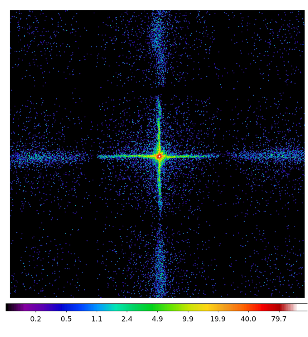Explosion-hunting telescope tested by Leicester space scientists ready for launch
Credit: CAS
A team of scientists at the University of Leicester have lent their expertise to test a space telescope that will search for some of the Universe’s most extreme and elusive explosions.
The Chinese Academy of Sciences (CAS) spacecraft Einstein Probe is ready to launch in January 2024. Equipped with a new generation of X-ray instruments with high sensitivity and a very wide view, this mission will survey the sky with high cadence and hunt for powerful blasts of X-ray light from mysterious celestial objects such as neutron stars and black holes.
Einstein Probe is a collaboration led by CAS with the European Space Agency (ESA), the Max Planck Institute for Extraterrestrial Physics (MPE), Germany, and the French Space Agency (CNES). In return for contributing to the development of this mission and the definition of its scientific goals, ESA will get access to 10% of the data generated by Einstein Probe’s observations.
A team of space scientists at the University of Leicester have been advising the mission team for many years, and in the last few years have been funded by ESA to calibrate and characterise the X-ray optics and detectors for the Wide-Field X-ray Telescope (WXT) on EP. Working with Chinese colleagues, they have measured the quality and capability of the WXT using facilities in the UK and Germany.
WXT has an optical modular design that mimics the eyes of a lobster and uses innovative Micro Pore Optics technology. This enables the instrument to observe 3600 square degrees (nearly one-tenth of the celestial sphere) in one shot. Thanks to this unique capability, Einstein Probe can keep a watchful eye on almost the entire night sky in three orbits around Earth (each orbit taking 96 minutes).
 Unlike the stars that dot our sky at night and reliably mark the constellations, most cosmic objects that shine in X-rays are highly variable. They are continuously brightening and dimming, and in many cases, they briefly appear before they disappear for long periods (then they’re called transient) or for good.
Unlike the stars that dot our sky at night and reliably mark the constellations, most cosmic objects that shine in X-rays are highly variable. They are continuously brightening and dimming, and in many cases, they briefly appear before they disappear for long periods (then they’re called transient) or for good.
Powered by tumultuous cosmic events, X-ray light from astronomical sources is unpredictable. Yet, it carries fundamental information about some of our Universe's most enigmatic objects and phenomena. X-rays are associated with collisions between neutron stars, supernova explosions, matter falling onto black holes or hyper-dense stars, or high-energy particles being spewed out from discs of blazing material circling such exotic and mysterious objects.
Professor Paul O’Brien led the work at Leicester and is also the ESA appointed scientist in the EP science team for the mission. He said: “EP combines accurate X-ray imaging with very large field of view. That unique combination provides sensitivity, good location accuracy and high detection rates. EP also has a more traditional X-ray telescope on board which can be quickly pointed at any new transient to follow its evolution, while simultaneously sending an alert to other facilities and the world-wide astronomy community.”
Professor Ian Hutchinson, who led the detector team at Leicester, said: “EP will monitor about half the sky every few hours, using roughly 20 minutes exposure at each location, and then repeat that survey several times per day. This totally unique capability will allow X-ray monitoring of sources on timescale from seconds (within an observation) to months. Hence, we can find new sources but also monitor known sources to catch them in outburst.”
Credit: CAS
Leicester have been pioneers in X-ray astronomy including hardware, both optics and detectors, for decades and their experience has been invaluable to provide assurance and confidence to the EP project. Dr Charly Feldman, Optics lead scientist in the Leicester team, said: “EP uses the same type of MicroPore Optics as those developed by Leicester scientists for ESA’s BepiColombo mission to Mercury but in a much wider field of view configuration and developed in China.” The detectors are new CMOS devices developed in China. These allow for faster readout at high temperatures than CCDs used previously on facilities such as XMM-Newton and Swift, for which Leicester built the X-ray cameras.
The capability of routinely spotting new X-ray sources is fundamental to advancing our understanding of the origin of gravitational waves. When two hyper-dense massive objects, such as two neutron stars or black holes, crash, they create ripples in the fabric of space-time that travel over cosmic distances and reach us. Several detectors on Earth are now able to register this signal but often cannot locate the source. If neutron stars are involved, such a ‘cosmic crash’ is accompanied by an enormous burst of energy across the light spectrum, especially in X-rays. By enabling scientists to study these short-lived events promptly, Einstein Probe will help us identify the origin of many of the gravitational wave impulses observed on Earth.
- The University of Leicester team for Einstein Probe comprises Professor Paul O’Brien, Professor Ian Hutchinson, Dr Hannah Lerman, Dr Charly Feldman and Dr Melissa McHugh from the School of Physics and Astronomy.